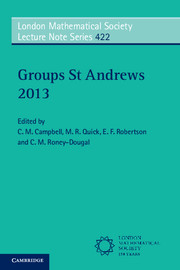Book contents
- Frontmatter
- Contents
- INTRODUCTION
- Approximate subgroups and super-strong approximation
- Width questions for finite simple groups
- Profinite properties of discrete groups
- GL(n, Z), Out(Fn) and everything in between: automorphism groups of RAAGs
- Permutation groups and transformation semigroups: results and problems
- New progress on factorized groups and subgroup permutability
- A survey on the normalizer problem for integral group rings
- A survey on Clifford-Fischer theory
- A generalisation on the solvability of finite groups with three class sizes for normal subgroups
- Automorphism groups of non-orientable Riemann surfaces
- What are the C2-groups?
- Resurrecting Wells’ exact sequence and Buckley's group action
- Recent work on Beauville surfaces, structures and groups
- Something for nothing: some consequences of the solution of the Tarski problems
- The groups of projectivities in finite planes
- On the relation gap and relation lifting problem
- Some results on products of finite subsets in groups
- Formal languages and group theory
- On the Castelnuovo-Mumford regularity of the cohomology of fusion systems and of the Hochschild cohomology of block algebras
- Recent advances on torsion subgroups of integral group rings
- On finite groups with small prime spectrum
- Solvability criteria for finite loops and groups
- The rational subset membership problem for groups: a survey
- A survey of Milnor laws
- Capable p-groups
- On the normal structure of a finite group with restrictions on the maximal subgroups
- Certain monomial characters and their normal constituents
- Recognition of finite quasi-simple groups by the degrees of their irreducible representations
- Generalized Baumslag-Solitar groups: a survey of recent progress
- Zeta functions of groups and rings – recent developments
On the normal structure of a finite group with restrictions on the maximal subgroups
Published online by Cambridge University Press: 05 September 2015
- Frontmatter
- Contents
- INTRODUCTION
- Approximate subgroups and super-strong approximation
- Width questions for finite simple groups
- Profinite properties of discrete groups
- GL(n, Z), Out(Fn) and everything in between: automorphism groups of RAAGs
- Permutation groups and transformation semigroups: results and problems
- New progress on factorized groups and subgroup permutability
- A survey on the normalizer problem for integral group rings
- A survey on Clifford-Fischer theory
- A generalisation on the solvability of finite groups with three class sizes for normal subgroups
- Automorphism groups of non-orientable Riemann surfaces
- What are the C2-groups?
- Resurrecting Wells’ exact sequence and Buckley's group action
- Recent work on Beauville surfaces, structures and groups
- Something for nothing: some consequences of the solution of the Tarski problems
- The groups of projectivities in finite planes
- On the relation gap and relation lifting problem
- Some results on products of finite subsets in groups
- Formal languages and group theory
- On the Castelnuovo-Mumford regularity of the cohomology of fusion systems and of the Hochschild cohomology of block algebras
- Recent advances on torsion subgroups of integral group rings
- On finite groups with small prime spectrum
- Solvability criteria for finite loops and groups
- The rational subset membership problem for groups: a survey
- A survey of Milnor laws
- Capable p-groups
- On the normal structure of a finite group with restrictions on the maximal subgroups
- Certain monomial characters and their normal constituents
- Recognition of finite quasi-simple groups by the degrees of their irreducible representations
- Generalized Baumslag-Solitar groups: a survey of recent progress
- Zeta functions of groups and rings – recent developments
Summary
Introduction
Our terminology and notation are mostly standard (see, for example, [1, 2]). We use the term “group” to mean “finite group.”
Let π be a set of primes. Denote by π_ the set of primes not in π. Given a natural n, we denote by π(n) the set of prime divisors of n. A natural number n with π(n) ⊆ π is called a π-number, and a group G such that π(G) ⊆ π is called a π-group. For a group G, the set π(G) = π(|G|) is the prime spectrum of G. A subgroup H of a group G is called a π-Hall subgroup if π(H) ⊆ π and π(|G : H|) ⊆ π’. Thus, if π consists of a single prime p then a π-Hall subgroup is exactly a Sylow p-subgroup. A Hall subgroup is a π-Hall subgroup for some set π of primes. A group G is prime spectrum minimal if π(H)≠ π(G) for every proper subgroup H of G.
We say that G is a group with Hall maximal subgroups if every maximal subgroup of G is a Hall subgroup. It is easy to see that every group with Hall maximal subgroups is prime spectrum minimal.
A group G is a group with complemented maximal subgroups if for every maximal subgroup M of G, there exists a subgroup H such that MH = G and M ∩ H = 1.
The study of groups with Hall maximal subgroups was started in 2006 by Levchuk and Likharev [3] and Tyutyanov [4], who established that a nonabelian simple group with complemented maximal subgroups is isomorphic to one of the groups PSL2(7) PSL3(2), PSL2(11) or PSL5(2). In all these groups, every maximal subgroup is a Hall subgroup. In 2008, Tikhonenko and Tyutyanov [5] showed that the nonabelian simple groups with Hall maximal subgroups are exhausted up to isomorphism by the groups PSL2(7), PSL2(11), and PSL5(2).
- Type
- Chapter
- Information
- Groups St Andrews 2013 , pp. 428 - 435Publisher: Cambridge University PressPrint publication year: 2015



